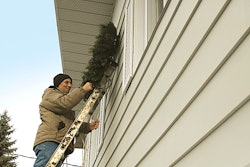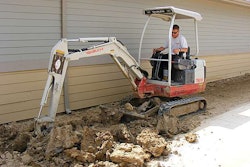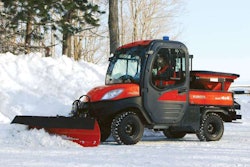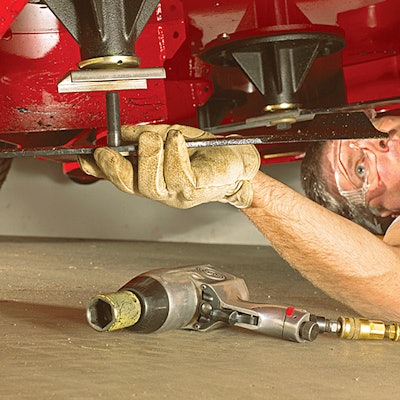
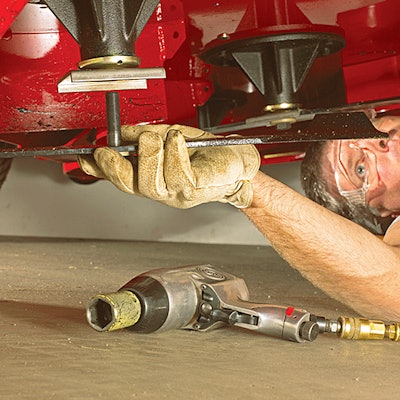
Take time now to do preventive maintenance so your equipment is ready for another full season.
Consult your owner’s manual for model-specific information. Most manufacturers post digital versions of their engine manuals and service schedules on their websites.
Get it clean
Start the winterizing process with a thorough cleaning. You can simply blow off the unit with compressed air. Then wash the unit, but avoid pressure washing since this can force water into areas where it shouldn’t go. Be thorough. Remove guards and clean under them. Get into the nooks and crannies – the battery box, under the seat, the corners of the mower deck, the cooling fins on engines and transmissions.
 Clean or replace all filters before the mower is stored.
Clean or replace all filters before the mower is stored.Next, do the usual preventive maintenance tasks for the engine. Replace air, oil, and fuel filters. Change the oil. Replace the spark plugs. On water-cooled engines, replace the coolant every year and the thermostat every two years. Check the condition of the hoses, clamps, and radiator. Make sure engine controls, such as throttle and choke mechanisms, are working properly.
Managing fuel
Most experts suggest gasoline should be treated before storage. If you store equipment for more than 60 days it may be best to use a fuel stabilizer to prevent gumming and residue. Mix the stabilizer well with the fuel and run the machine long enough to ensure the mixture runs through the carburetor. Stabilizers are recommended for storage for up to six months. For longer storage, the fuel system should be drained.
 Lube only where recommended and don’t overdo it.
Lube only where recommended and don’t overdo it.Other experts argue fuel should be removed from stored equipment because of ethanol, which is alcohol that attracts moisture from the air. During storage, phase separation occurs when this alcohol and water mixture settles to the bottom of the fuel tank. When you fire up your engine it can cause damage.
Large, 4-stroke engines in ride-on mowers are more accepting of crummy fuel than small, 2-stroke engines. Still, draining fuel may be a good idea. If you choose to do so, be sure to pump the purge bulb, if there is one, and run the engine until the system is dry.
Diesel fuel is less volatile than gasoline and can be stored for longer periods without treatment. Inspect the fuel occasionally for algae; if the fuel is contaminated, it will look and smell bad. Drain the water separator and replace or clean the diesel fuel filter. Inspect the entire system closely. Look for cracked lines, loose clamps, brittle O-rings, and other problems. Remember to check the tank vent.
Beyond the engine
Inspect tires for cuts, ply separation, and other damage. Repair or replace wheels if they have suffered heavy impact damage or are heavily rusted. On mechanical transmissions, check the linkages for wear or damage.
On hydrostatic drives, check the pumps, wheel motors, and hydraulic lines for leaks. Change the fluid and filter as recommended. Inspect the fluid for signs of overheating (stinky fluid), water (milky fluid), or component damage (metallic fluid). Lubricate chassis components as directed by the manufacturer. Grease and oil attract and hold dirt, so don’t overdo it.
 To keep the mower clean use a fitted cover or tarp.
To keep the mower clean use a fitted cover or tarp.Check electrical systems for proper function. Make sure all switches and alarms are operable. Check the function of safety interlocks. Follow the wiring to make sure it’s held away from moving parts and is not corroded or worn.
Pay special attention to connectors, as they’re the point of failure on most electrical problems. Ground contacts should be clean and tight. Extend your electrical system inspection to the power take-off. In addition, inspect the PTO’s anti-rotation device; it may have become loose or worn during the season. Also check the PTO bearings and the clutch securing bolt.
Sharpen and balance mower blades. Replace blades that have excessive wear, rock damage, or other faults that prevent them from being sharpened and balanced. A light coating of oil will help prevent rust.
Look at the mower from the operator’s perspective. The seat should not be torn or tilted. Rubber grips should still cover control levers. Non-slip surfaces should provide firm footing any place a boot comes down. Gauges and indicator lights should be clear and functional and guards and covers in place.
As a final step, make sure all fasteners are secure. Review the owner’s manual to see which fasteners, if any, have specific torque values.
Put it to bed
Batteries can be left unattended for several months. Charge the battery fully before storage. A cool storage environment and a clean battery case will reduce discharge. You can also disconnect the negative terminal. Even though the current loss is minimized, keeping a battery charged while in storage may extend its life.
Use a true, fully automatic charger that senses the battery’s condition and alters the charge rate accordingly. Extend tire life by supporting the mower with wooden blocks under its frame. Tires and other rubber components are damaged by ozone, which is produced by electrical equipment.
EDITOR’S NOTE: This article was written by Richard Ries.
